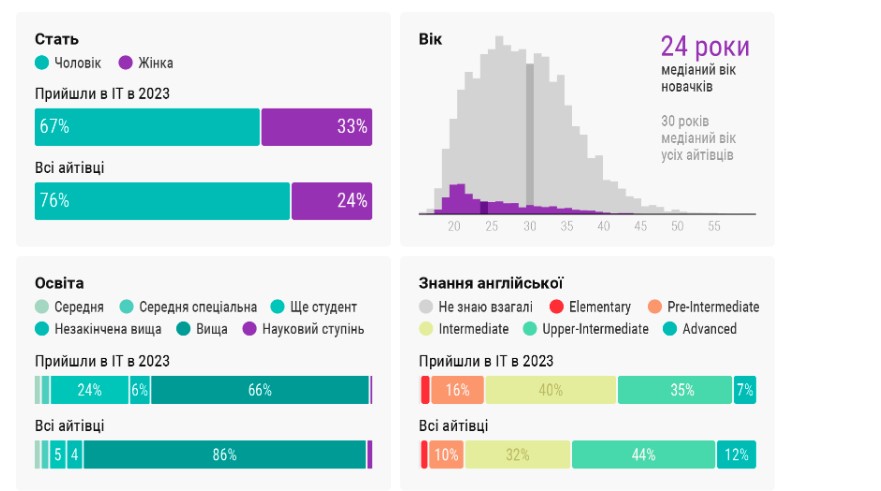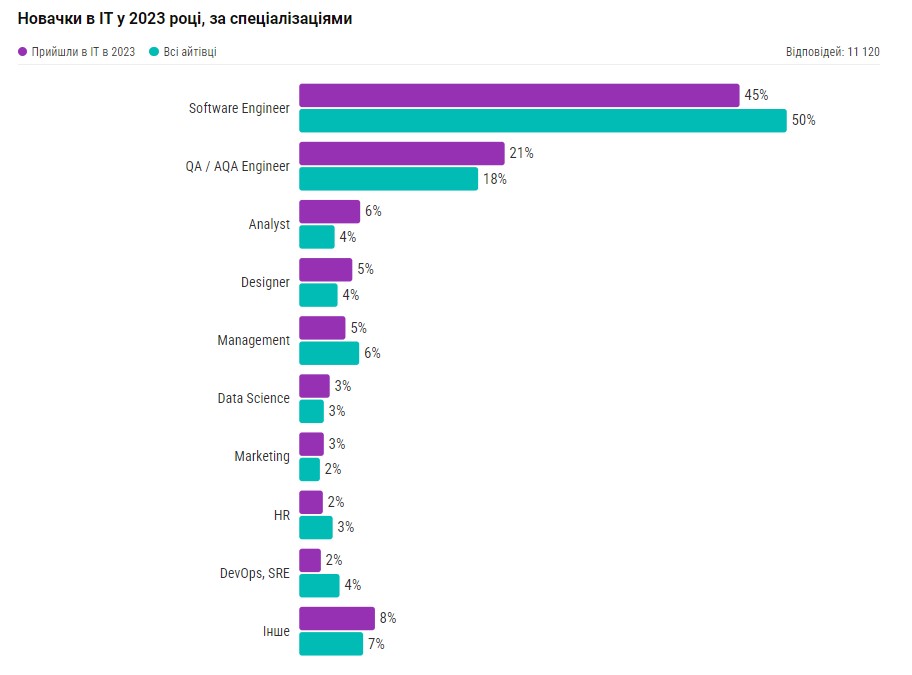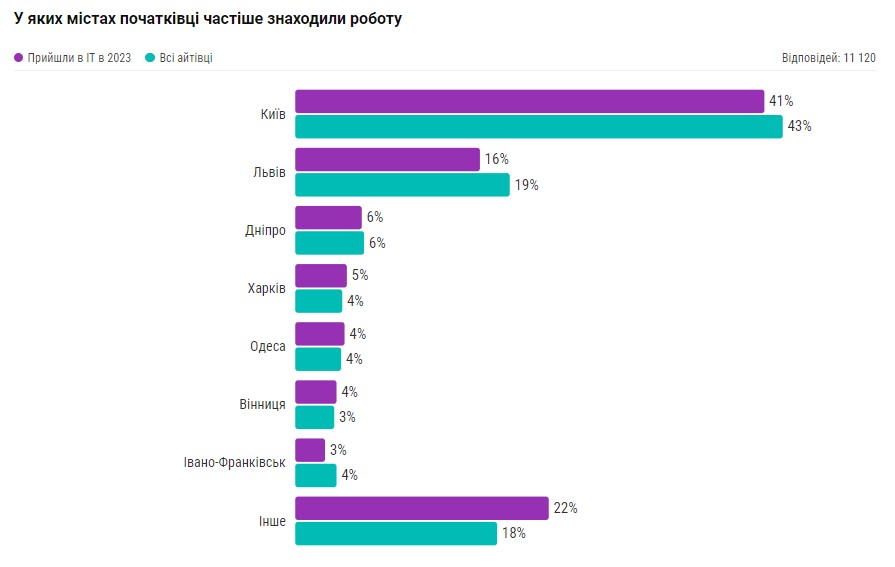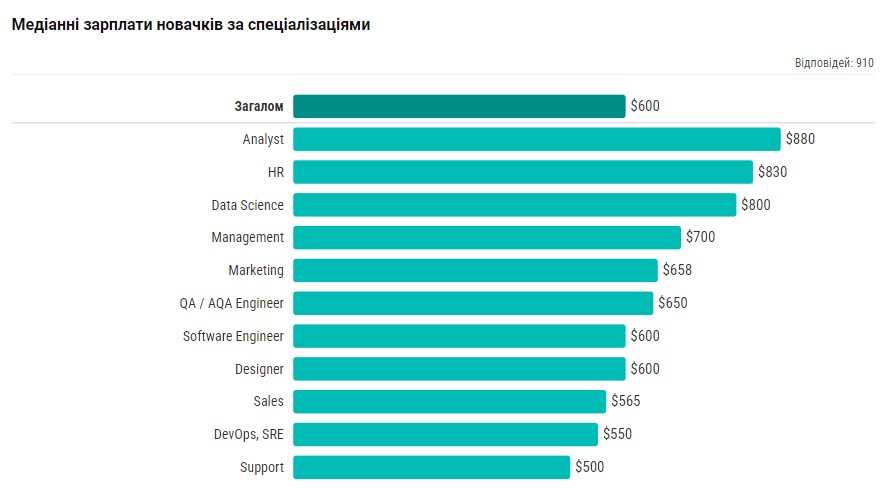The average salary of those who found their first job in IT last year was $600.
About it says in the DOU statistics based on the results of the winter survey.
Half of newcomers to IT are developers
Technical specialists account for 85% of those who found their first job in IT last year. Most often, these are developers (45%) and QA (21%). The share of developers among those entering IT has remained stable since the start of the full-scale invasion.
The demand for QA specialists grew steadily until 2022: at the beginning of that year, testers accounted for 26% of IT professionals starting their careers. After 2022, the share of testers in new hires began to decline and last year amounted to 21%.
The demand for non-technical specialists remains at the same level as before the full-scale invasion, but the structure of hiring these specialists has changed.
- 15% of those who found their first job in IT last year have a non-technical specialization — the same number as in 2021.
- Among non-technical specialists who found their first job in IT last year, designers are the most numerous (5%).
- Marketing specialists are in second place (3%).
- HR/recruiters and sales specialists account for 2% each of those who entered IT last year, but the trends for these specializations are different.
- The share of salespeople in new hires has been growing since the start of the full-scale invasion, while the share of HR, recruiting, and L&D specialists has been falling.
Small companies were more active in hiring
Small and medium-sized companies were more active in hiring newcomers last year than large ones. 76% of IT professionals with a year or less of experience in IT work in companies with less than 200 employees (56% of Ukrainian IT professionals work in such companies overall).
Most often, newcomers work in product (40%) or service companies (37%).
They found it easiest to find a job in Kyiv (41%) or Lviv (16%).
Most of the world’s most skilled QA specialists
Young people are most often joining the IT industry: the median age of specialists who found their first job last year is 24. Only a quarter of new IT professionals are 30 years old or older.
The youngest — developers, DevOps, Data Science/Data Engineers, as well as support specialists and sales and business development specialists — are 21-22 years old, meaning that more than half of these professionals started working as students.
In QA, project management, HR/recruiting, marketing, and design, there are more sweatshops coming from other fields. Most of the sweaters are in QA – 41% of testers who found their first job in IT last year are over 30 years old. Among RMs, there are 36% of them, and among marketers — 29%. The majority of HR and recruiters who joined IT last year had more than 2 years of experience in this specialization on average, but in other areas.
About a third of all new professionals are women. They most often start their careers in IT as QA (28% of all women who found their first job last year) and developers (20%).

73% of those who entered IT last year have higher or incomplete higher education, and another 24% are currently studying at a university. Only 3% of professionals have no higher education and are not currently studying.
English level The language level of newcomers is mostly intermediate (40% rated it as Intermediate) or above intermediate (35% — Upper Intermediate). In this respect, they are inferior to their more experienced IT colleagues, who usually have a higher level of English.
PM, Data Science/Engineering, and Sales professionals have the best English skills among newcomers (more than 60% of them have Upper Intermediate and above). Developers and QA usually have a lower level: about 45% of them rated their level as Intermediate.
QA, designers, HR, recruiters and L&D and support specialists are more likely to find a job in IT without English: more than 20% of those who found a job in IT last year in these areas rated their level as Pre-Intermediate or lower.
Median salary of newcomers
The median salary of those who joined IT last year is $600, and there are few differences in salaries between different specializations.
Analysts ($880), HR and recruiters ($830), and Data Science/Engineering specialists ($800) have the highest salaries among newcomers.
HR/recruiters who joined IT last year often already had experience in their specialization gained outside of IT (2.2 years on average), which is why their high salaries are so high. However, even experienced HR and recruiting professionals are finding it difficult to get into IT nowadays: only 6% of HR/recruiters have been working in IT since 2023, which is less than the average for all specializations (9%).
Analysts and Data Science/Engineering specialists have the opposite situation — these specializations are now open to newcomers. 15% of analysts and 11% of Data Science/Engineering specialists entered the IT industry last year, and the demand for these specialists affects their salaries. Some analysts moved to IT from other fields, already having some experience in their specialization (12% of them have a Middle or higher title vs. 5% of all newcomers to IT), which also affects their median salary.
Support specialists who are just starting their careers are the least likely to be paid: their median salary last year was $500 per month. Also, the average salaries of beginners in DevOps ($550) and in sales and business development ($565 — but this amount does not take into account bonuses, which can be quite large).






Spelling error report
The following text will be sent to our editors: